YUME KŌJŌ - DOKI DOKI PANIC
|
|
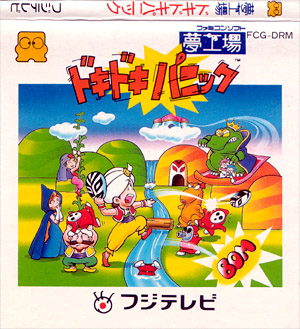
|

|
|
夢工場ドキドキパニック
©1987 Nintendo / Fuji TV
Release: 1987-07-10 (¥2980)
DiskCard FCG-DRM
Action / Platform game
|
Yume Kōjō - Doki Doki Panic is a cute platform game by Nintendo.
The story starts with two chidren, the young twins Piki and Poki,
peacefully reading a story book. However, they accidentally tear off the last page
of the book - little did they know that the book is actually magic! The evil
Mamū suddenly appears, and his huge three-fingered
hand pulls them into a quirky dream world. The goal of Doki Doki Panic
is to help the whole family (namely Imajin, Lina and their parents
Mama and Papa) rescue their poor children kidnaped by the evil king lizard.
Each member has its own strengths and weaknesses - Imaji is a balanced
character whereas Lina is fairly light weight and can effortlessly hover and fly over short
distances, but she is really slow at picking up items. Papa is the strongest of the group
and can throw enemies and items really far, whereas Mama can jump higher than anyone. As
aforementioned, each character can carry enemies, items, and especially radishes and other
vegetables that can be pulled out of the ground and used as lethal weapons. The game features
a myriad of other items, such as bombs (self explanatory), Power blocks (similar
to Mario Bros's POW blocks that kill all enemies on screen), Stars
(temporary invincibility), keys (to unlock doors), Hearts (extra health) or the
mysterious magic lamps that open doors to the Dark World - mirror areas where our
heroes can find special items or heart containers. Doki Doki Panic follows a story book
structure, and is made out of seven chapters (areas) and twenty pages (levels). Interestingly,
although the player can play the Doki Doki Panic with any character, it has to eventually
defeat the evil Mamū with all four to finally beat the game (the player can separately
save each character's progress).
|
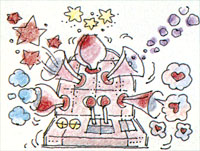 Yume Kōjō - Doki Doki Panic can be translated as 'Dream Factory - heart pounding panic'.
Doki Doki in Japanese is an onomatopoeia, or a sound symbolism, used to
describe a rapidly beating heart (similar to 'thump thump' in English).
'Dream Factory' is however related to the Fuji Television event
the game is tied-in (see below). It is also at the core of the game's story.
The plot takes place in a dream world inhabited by the Muu people.
There, even the weather is controlled by the people's dreams, good dreams
bring sun and warmth, bad dreams clouds and rain. A dream machine was created to help
the inhabitants leave in peace and harmony with their dreams. However, one day,
the evil Mamū took over the machine and used it to
Yume Kōjō - Doki Doki Panic can be translated as 'Dream Factory - heart pounding panic'.
Doki Doki in Japanese is an onomatopoeia, or a sound symbolism, used to
describe a rapidly beating heart (similar to 'thump thump' in English).
'Dream Factory' is however related to the Fuji Television event
the game is tied-in (see below). It is also at the core of the game's story.
The plot takes place in a dream world inhabited by the Muu people.
There, even the weather is controlled by the people's dreams, good dreams
bring sun and warmth, bad dreams clouds and rain. A dream machine was created to help
the inhabitants leave in peace and harmony with their dreams. However, one day,
the evil Mamū took over the machine and used it to
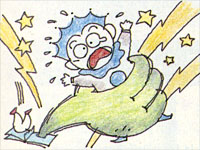 create an army of monsters. The Muu soon find out that Mamū
has only one weakness - vegetables - and they join forces to defeat him.
When the game starts, Mamū had been sealed away a long time ago... but
he is about to be awaken by the young twins Piki and Poki. On day, as the
two children read a magic story book, they start fighting and accidentally
tear off the last page, the one describing how Mamū was
defeated by the Muu people. The evil monster returns and drags the two
children with him into the Dream World.
create an army of monsters. The Muu soon find out that Mamū
has only one weakness - vegetables - and they join forces to defeat him.
When the game starts, Mamū had been sealed away a long time ago... but
he is about to be awaken by the young twins Piki and Poki. On day, as the
two children read a magic story book, they start fighting and accidentally
tear off the last page, the one describing how Mamū was
defeated by the Muu people. The evil monster returns and drags the two
children with him into the Dream World.
|
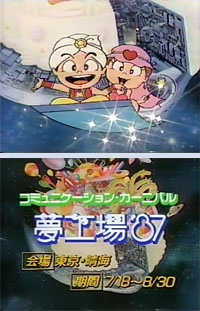 Yume Kōjō - Doki Doki Panic is tied in with a Fuji Television promotional
event. The Yume Kōjō'87 festival (picture on the right), as it was called and which translates as
"Dream Factory'87", was designed to promote the latest shows from the TV station,
and it was held simultaneously in Tokyo and Osaka from July 18th to August 30th 1987. The
Yume Kōjō family was the official mascot of the festival, and it was a logical
choice for Nintendo to feature them in the game. Interestingly, all the
odd masks featured in the game seem to also be a direct reference to the festival.
Most of the original Super Mario team was involved in the game's development, namely Shigeru Miyamoto (producer),
Kensuke Tanabe (director) and Koji Kondo (music) - which may explain why Yume
Kōjō Doki Doki Panic was the perfect alternative for the western release of
Super Mario Bros 2 (read below). Finally, a contest was organized to commemorate
the released of Yume Kōjō - Doki Doki Panic. The instruction manual
indicates that players could send a proof of purchase (a seal included with the
game) to win one of 2000 phone cards (These phone cards periodically appear on Japanese auction
sites today, so it doesn't look like it was a limited run, see the Omake section).
Yume Kōjō - Doki Doki Panic is tied in with a Fuji Television promotional
event. The Yume Kōjō'87 festival (picture on the right), as it was called and which translates as
"Dream Factory'87", was designed to promote the latest shows from the TV station,
and it was held simultaneously in Tokyo and Osaka from July 18th to August 30th 1987. The
Yume Kōjō family was the official mascot of the festival, and it was a logical
choice for Nintendo to feature them in the game. Interestingly, all the
odd masks featured in the game seem to also be a direct reference to the festival.
Most of the original Super Mario team was involved in the game's development, namely Shigeru Miyamoto (producer),
Kensuke Tanabe (director) and Koji Kondo (music) - which may explain why Yume
Kōjō Doki Doki Panic was the perfect alternative for the western release of
Super Mario Bros 2 (read below). Finally, a contest was organized to commemorate
the released of Yume Kōjō - Doki Doki Panic. The instruction manual
indicates that players could send a proof of purchase (a seal included with the
game) to win one of 2000 phone cards (These phone cards periodically appear on Japanese auction
sites today, so it doesn't look like it was a limited run, see the Omake section).
|
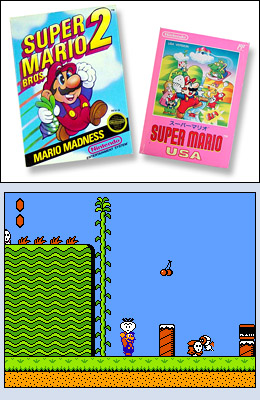 Yume Kōjō - Doki Doki Panic is now widely known by the video game community for
an interesting reason - back in 1988, Nintendo America decided to modify the original
game and to release it in North America as Super Mario Bros 2. What is especially
intriguing is the fact that a version of Super Mario Bros 2 had already been released in
Japan in 1986 - it was a totally different game based on Super Mario Bros, it
looked and played like the original with a higher difficulty level (it was released in the west
in 1993 as Super Mario Bros The Lost Levels for the Super Nintendo, and included
in Super Mario All-Stars). Anyway, back to the western release of Super Mario Bros 2.
Classic Nintendo characters such as Mario himself, Luigi, Princess Peach,
Toad and Wart were substituted to the Yume Kōjō family and to the original villain
Mamū. Then the option to hold the B button to run faster was added to the gameplay, and
this Mario trademark move was not available in Doki Doki Panic. Most of the other
differences between the two titles are small graphical and animation changes, such as power-ups,
mushrooms, items and a couple of bosses. Finally, the western version of the game was released in
Japan in 1992 as Super Mario USA.
Yume Kōjō - Doki Doki Panic is now widely known by the video game community for
an interesting reason - back in 1988, Nintendo America decided to modify the original
game and to release it in North America as Super Mario Bros 2. What is especially
intriguing is the fact that a version of Super Mario Bros 2 had already been released in
Japan in 1986 - it was a totally different game based on Super Mario Bros, it
looked and played like the original with a higher difficulty level (it was released in the west
in 1993 as Super Mario Bros The Lost Levels for the Super Nintendo, and included
in Super Mario All-Stars). Anyway, back to the western release of Super Mario Bros 2.
Classic Nintendo characters such as Mario himself, Luigi, Princess Peach,
Toad and Wart were substituted to the Yume Kōjō family and to the original villain
Mamū. Then the option to hold the B button to run faster was added to the gameplay, and
this Mario trademark move was not available in Doki Doki Panic. Most of the other
differences between the two titles are small graphical and animation changes, such as power-ups,
mushrooms, items and a couple of bosses. Finally, the western version of the game was released in
Japan in 1992 as Super Mario USA.
|
Game Staff (Copied from the game's end credits) :
|
STAFF
Executive Producer
H. Yamauchi
Producer
Miyahon
Director
Chappy
Assistant Director
Hide Q
|
|
Character Design
Sugiyan
Fuji TV
Title Design
Isshin
Course Design
Tanabe
Yamahem
Konno
|
|
Sound Composer
Konchan
Programmer
Nakazou
Tahyan
Iwachan
M rikazu rikazu
Tomichan
Shigechan
N. Akiira
Marumaru
|
|
Meddler
Ten Ten
Otabe
Mako
Benkei
Thanks a million.
|
|
G
O
O
D
I
E
S
|
|
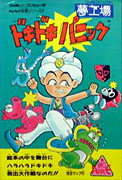
Japanese Guidebook
|
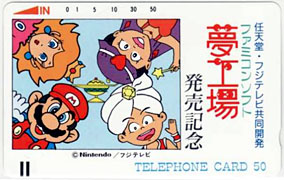
Japanese Phone Card
|
|
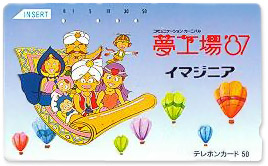
Japanese Phone Card (Yume Kōjō'87 festival)
|
|
|
O
M
A
K
E
|
|
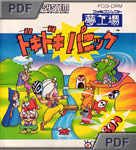

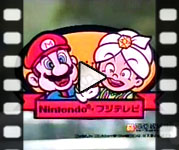
|
|
|
Click on picture to enlarge |
|
|
|
LK

|
|
Add your Pov here !
|
P
O
V
s
|
|
Doki Doki Panic can be disturbing at first, especially for anybody already familiar with
Super Mario Bros 2 and its timeless soundtrack. These tunes can hardly be dissociated from
Mario, in a way very similar to how Disney's The Sorcerer's Apprentice became indelibly
associated with Paul Dukas's compositions. The game's gameplay mechanics and design are just
incredible, and the list would be much too long to be entirely listed here. Four characters with four
different sets of skills, and all the level design has been built to handle them seamlessly! The
ability to jump over and grab anything is pure genius. Finally, it is amusing to notice that this
game was modified to become the Mario game we all know and love. But a lot of the elements
that make Mario games so entertaining and unique originally appeared in Doki Doki Panic - the
jazzy music tunes, the multiple skills giving the characters the ability to reach new areas, the
non-linear levels and hidden passageways. I sometimes wonder if this game wasn't originally supposed to be a Mario
game, even in Japan... All in all, Doki Doki Panic is a timeless classic and another
Nintendo stunning masterpiece.
|
|
|
|